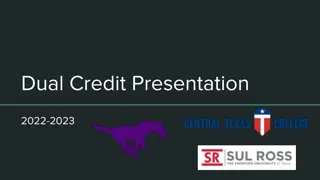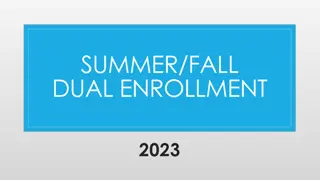Dual Credit Reporting Guidelines for College Courses
Dual Credit Reporting provides definitions, guidelines, and validation rules for reporting college courses that allow students to earn both high school and college credit. Key elements covered include credit indicators, college credit hours, course sequencing, and validation rules to avoid overreporting. The guidelines stress the importance of aligning reporting with college course structures and emphasize the correct method to report hours for dual credit courses.
Download Presentation

Please find below an Image/Link to download the presentation.
The content on the website is provided AS IS for your information and personal use only. It may not be sold, licensed, or shared on other websites without obtaining consent from the author. Download presentation by click this link. If you encounter any issues during the download, it is possible that the publisher has removed the file from their server.
E N D
Presentation Transcript
Simple Solution. Brighter Futures. DUAL CREDIT REPORTING July/August 2018 Presented by: Melissa Lemons
Dual Credit Reporting Definitions 2 Definitions: PASS/FAIL-CREDIT-INDICATOR-CODE (E0949) Indicates the outcome for a course taken by a particular student. DUAL-CREDIT-INDICATOR-CODE (E1011) Indicates whether the student was eligible to receive both high school and college credit for a college course. COLLEGE-CREDIT-HOURS (E1081) Indicates the number of college hours a student earned for the completion of a dual credit course. COURSE-SEQUENCE-CODE (E0948) Identifies the unique part(s) of a course when a course is taught during a single grading period or semester or across multiple grading periods or semesters. The course sequence code identifies how the course was taught to the student during the school year, or in the summer.
Dual Credit Reporting - Guidelines 3 When a student completes a dual credit course and receives college credit hours, the course sequence code should be 0 to align with how college courses are generally taught (single semester basis). Reporting dual credit courses with any course sequence code other than 0 can result in overreporting of college credit hours.
Dual Credit Reporting - Guidelines 4 Example of passing a dual credit course with college credit hours: Course Pass/Fail Credit Indicator Code (reported) College Credit Hours 3 hours Dual Credit Indicator Code 1 yes Course Sequence Code 0 One Semester Course College Algebra I 01 Course Was Passed And Credit Was Received Correct way to report hours. College Algebra I 01 Course Was Passed And Credit Was Received 3 hours 1 - yes 1 - First Half Of A Two Semester Course 2 - Second Half Of A Two Semester Course Incorrect way to report hours. Incorrect way to report hours. College Algebra I 01 Course Was Passed And Credit Was Received 3 hours 1 - yes
Dual Credit Reporting Business Validation Rules 5 Dual credit college courses are generally single semester courses. Rule Applies To Rule # Rule Text / Business Meaning Error Level TSDS PEIMS Sub ESC District Campus Charter 43415-0069 (NEW) If DUAL-CREDIT-INDICATOR-CODE is "1", then COURSE-SEQUENCE-CODE should be "0". W 3, 4 X X X Dual credit college courses should follow the design of the college course being taken, which is generally taught on a single semester basis.
Questions? 6 Questions?























